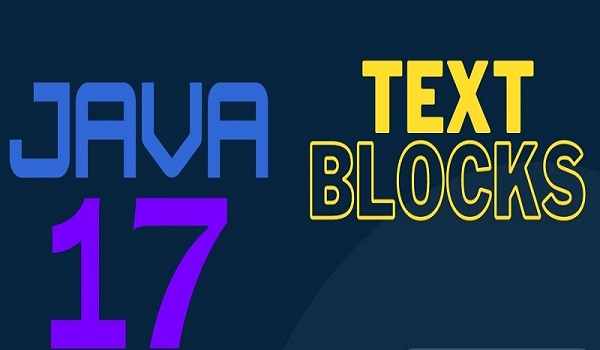Overview Text Blocks in Java 17
Introduced in Java 17, text blocks are a potent tool that makes managing multi-line texts easier and improves readability and maintainability. They avoid the need for complicated escape sequences and concatenations that are typical of ordinary string literals by enclosing the text in triple-double quotes (“”). Because of this, text blocks are perfect for working with structured forms such as SQL queries, HTML, JSON, and XML.
Additionally, text blocks in Java 17 support objective of minimizing boilerplate code, freeing developers from having to worry about string syntax management and enabling them to concentrate on problem-solving. For Java application development, text blocks offer a sophisticated and effective way to create templates, logs, or searches.

Better readability, automated line break management, and built-in functions like formatted() for dynamic content insertion and stripIndent() for indentation control are some of the main advantages. Without compromising functionality, developers may design code that is clearer and easier to understand.
READ – Understanding Java 17 Records: Benefits, Features, and Limitations
What are Text Blocks?
Multi-line string literals, or text blocks, were introduced in Java 17 to make handling and reading long-formatted texts easier. Enclosed in triple double-quotes (`”””`), they enable natural text organization in the source code, retain line breaks, and lessen the need for escape sequences. When producing HTML, SQL, JSON, or any other structured information, this functionality is very helpful since it makes the code clearer and easier to maintain.
With formatting choices like `formatted()` and techniques like `stripIndent()`, text blocks can facilitate indentation control. Text blocks in Java 17 are an important feature for effective string manipulation since they increase readability and decrease boilerplate.
Key Features of Text Blocks
- Improved Readability: Text Blocks achieve the natural structure of the text, making it easier to read and understand.
- Automatic Line Break: Line breaks are preserved as written in the source code.
- No need for escape characters: Special characters like quotes and backslashes require fewer escape sequences.
- Concise Syntax: Boilerplate code is decreased by text blocks, particularly when working with multi-line strings.
Syntax of Text Blocks
The basic syntax of text block is:
String textBlock = """
This is a text block.
It spans multiple lines.
""";
Some Real World Examples of Text Blocks in Java 17
Example 1: HTML Content
Concatenation and character escape are necessary when defining an HTML snippet using conventional string literals:
String html = "<html>\n" +
" <body>\n" +
" <h1>Hello, World!</h1>\n" +
" </body>\n" +
"</html>";
With the help of text blocks the HTML template becomes more readable:
String html = """
<html>
<body>
<h1>Hello, World!</h1>
</body>
</html>
""";
Example 2 : SQL Query
Let’s Consider a SQL Query written in traditional string literals :
String query = "SELECT * FROM users\n" +
"WHERE age > 30\n" +
"ORDER BY name;";
The SQL query seems clearer and easier to understand when text blocks are used:
String query = """
SELECT * FROM users
WHERE age > 30
ORDER BY name;
""";
Example 3 : Using JSON Content
Multiple degrees of nesting are frequently present in JSON strings, which can be difficult to handle with conventional string literals:
String json = "{\"name\": \"John\", \"age\": 30, \"city\": \"New York\"}";
With text blocks, JSON Content is easier to write and maintain:
String json = """
{
"name": "John",
"age": 30,
"city": "New York"
}
""";
READ – Java Pattern Matching for Switch
Working with Text Blocks in Java 17
Indentation Management
Here text blocks automatically determine the common leading white space and remove it. The developer can also explicitly control Indentation using the “stripIndent()” method or format the content using “formatted()”.
Example:
String textBlock = """
Line 1
Line 2
Line 3
""";
System.out.println(textBlock.stripIndent());
Combining Text Blocks in Java 17 with Methods
Text Blocks in Java 17 work seamlessly with methods like “string.format” and “string.replace”.
Example:
String template = """
Dear %s,
Your order #%d has been shipped.
Thank you,
Customer Service
""";
String message = template.formatted("Alice", 12345);
System.out.println(message);
Conclusion
By maintaining the text’s natural layout, they make dealing with organized content—such as HTML, JSON, SQL, and XML—easier. Their versatility and usefulness are further increased by the ability to apply dynamic formatting with formatted() and control indentation with techniques like stripIndent(). Teams may simplify projects and concentrate on producing more expressive, lucid code by implementing text blocks in Java 17.
Java Developers may avoid typical errors related to standard string concatenation and escape by using text blocks to produce more understandable and maintainable code. This feature is essential to contemporary programming as it supports Java’s dedication to developer productivity and code quality.
Read more:



